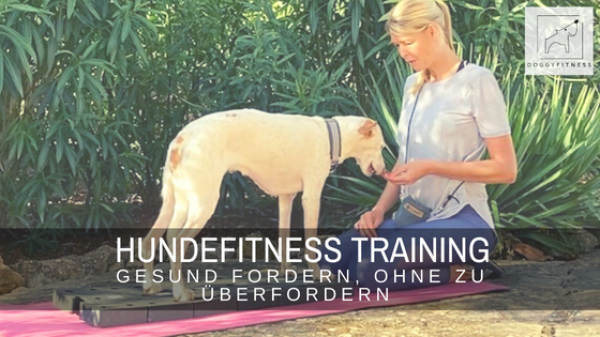Dog fitness training is becoming more and more popular. Not without reason. It’s a great way for dog people to actively do something for their dog’s health. Active movement therapy or dog fitness training aims to build muscles, improve joint mobility, strengthen body awareness, coordination, endurance and balance. It can also be used to treat paralysis. Various devices such as cavaletti, slalom, balance cushions, etc. can be used. But even without equipment, there are many exercises that can be used. Here we can mention, for example, isometric exercises or everyday movements.
What should you know if you want to get into dog fitness?
Anyone who has ever dealt with the subject of fitness in the human field knows that this is not so simple.
For example, it is necessary to know: Training dog fitness
- Which exercise trains which part of the body in which way?
- How complex is the exercise?
- Can the body provide them?
- Are there any contraindications for the exercise?
- How many repetitions make sense?
- How do I combine exercises in a meaningful way?
All these questions should also be asked when you practice fitness training with your dog. For a layman, these are not easy to answer. The key here is to know exactly how fit the dog is and what it can do. It is also important to evaluate his physical needs.
Get professional support training dog fitness
These points can be assessed by a specialist. By this I mean a canine physical therapist who is also knowledgeable in canine fitness and exercise training. That’s why I would definitely advise you not to just experiment wildly yourself and come up with exercises. It’s better if you approach training with a concept, even a training plan. Moreover, such a plan should have been prepared by a professional, i.e. a physiotherapist. This allows you to have a structured training, you can define goals and also ensure measurability at the same time.
Protect your dog from overstraining during training
Also in dog fitness applies: quality before quantity and much does not help much. If you do too much, i.e. you overload your dog, then this will significantly worsen the training result. But going over the limit does not only mean that your dog can’t do an exercise correctly, and if necessary, that your dog can’t do it. stumbles and fails. It means that physical discomfort can occur, such as sore muscles, tension or joint pain. It also means that the training frustrates him. The fun of the joint activity is lost, as is the health-promoting aspect. Training dog fitness
The same applies if you use exercises that your dog is not (yet) physically up to. He will not be able to perform them correctly and cleanly. The training effect is absent and instead, tension or muscle soreness can occur.
Challenge instead of overchallenge training dog fitness
This means always training according to need. Exercises should always be selected from easy to complex. As the dog develops, these can then adapt in complexity. The intensity of the training can also grow with the physical development of the dog.
Regarding the training surface, I advise you to always perform exercises on a firm surface first and then use more pliable surfaces. Here, too, there are differences. First you should choose less yielding substrates and only then softer ones.
My tip: Try out for yourself how intense it feels to move on the different training tools. Feel for yourself the difference of running over cavalettis that are low and evenly spaced and then ones that are different heights and positioned at different distances. I am sure you will feel the difference yourself. Training dog fitness
Your dog feels the same way. Introducing new movements and exercises in training may challenge your dog. However, it should always present him with solvable tasks. Too much ambition is out of place here. It is a matter of developing at the dog’s pace and not as the dog person would want.
PS: Regular breaks are as much a part of training as your workouts. They allow the dog’s body to process what it has been trained to do and “grow” from it.
I wish you and your dog much joy in your training! Training dog fitness
You have questions about the training? Then feel free to leave me a comment or write me at tina@doggy-fitness.de.
All the love, your Tina
Dieser Beitrag ist auch verfügbar auf:
Français (French)
Deutsch (German)
Español (Spanish)
















